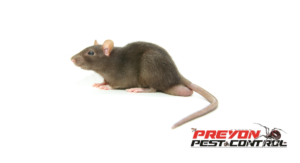Woodrats are the problem of every house in the US. Many people are fed up to rid of them from their houses. But you don’t need to worry about this because Preyon Pest Control is the best company in the US who’s providing the best services; you can contact them at 708-232-7703.
Identification Of Woodrats
Actual length: 14″ to 17″ including the tail.
How do you identify a woodrat? Large, brownish-brown in color with a white or grayish belly. Tail with fur. Habitat: Can be found in a variety of settings, including dry deserts, mountains, and plains. Builds large exposed nests and may invade attics, sheds, and wall voids in dwellings.

Habits:
- Often referred to as pack rats or trading rats.
- Attracted to and accumulates sparkling, bright stuff
- Make nests using sticks, cacti, and other detritus.
Woodrats are nocturnal, solitary rodents noted for their attraction to fascinating, shiny objects. When woodrats come across a bullet casing, coin, soda can tab, or piece of jewelry, they will carry it until they come across another, more fascinating thing, leaving the old behind and moving on with the new. Their actions earned them the nicknames “packrat” and “trade rat.” Woodrats may nest in buildings and feed on available food within the structure, but they usually continue to graze outside.
Habitat of the Woodrat
Woodrats make large, uncovered nests out of sticks, cacti, and other organic waste. Woodrats have been recorded entering homes and other structures under construction. They are strong climbers and can get into attics, crevices between walls, and rock overhangs. Once entered, woodrats exhibit the same chewing and property damage behaviors as the more common structural rats and mice. Large stick nests beneath a porch, in a woodshed, or in an attic are indications of a woodrat’s presence.
Habits, Threats, or Dangers of Woodrats
Woodrats are considered a minor pest throughout the country; but, when these rodents get access to residences, they can cause issues by shredding mattresses and upholstered furniture to line nests. Woodrats can play a vital role in the spread of illnesses and parasites such as fleas. Although their involvement in disease transmission is considered small, dead or dying wood rats should not be handled with bare hands. Contact pest control professionals if you find woodrats on or near your Chicago property.
Despite being classed as a “rat,” the Allegheny woodrat lacks all of the negative features of its rat kin. Because the woodrat is gentle and impeccably clean, it poses no risk to human health or safety. It lives in areas that are infrequently visited by humans, reducing the possibility of human/woodrat interactions. Now getting rid of wood rats is so easy with Preyon Pest Control.
DESCRIPTION
The Allegheny woodrat is a medium-sized nocturnal rodent that looks like a white-footed mouse. An adult woodrat is 15-18 inches long, including its seven-inch tail. The woodrat’s tail is thickly hairy and distinctively bicolored, with brownish black on top and white below. The fur is long and velvety, and the color is brownish-gray or cinnamon, with a white tummy and feet. A mature woodrat weighs about nine ounces. Immature woodrats are grayer in color, especially on the belly.
STATUS
Over around 35% of its native range, the Allegheny woodrat is extinct or declining. Woodrats previously roamed as far north as Chicago, according to fossil remains. However, their contemporary distribution is primarily restricted to limestone and sandstone cliffs along the Rivers and Crawford counties.
HABITAT
The Allegheny woodrat prefers rocky regions in deciduous forests as its favored habitat. They can be found in Indiana in small caves or rock crevices and fissures in steep cliff faces. Their home range measures about 100 yards in circumference.
DIET
The woodrat’s diet is primarily composed of plant components. Buds, leaves, stems, fruits, seeds, acorns, and various nuts are all included. Food is “cached” in enormous mounds known as middens. Woodrats consume roughly 5% of their body weight in dry materials on a daily basis.
REPRODUCTION
The breeding season in Indiana is most active in April and May. A litter of two to three young is born after a gestation period of 30-37 days. Within a month, young woodrats are weaned. Sexual maturation occurs in less than a year. In late summer, some females will have a second litter. A few early-born females may reproduce the same year they were born. The nests of Indiana woodrats are globular in shape and well-formed. They measure 15-18″ in diameter and have a five-inch-diameter “cup” in the center. The inside of the nest is lined with finely shredded red cedar bark. Nests are utilized for both year-round refuge and raising young.
LIFESPAN
Woodrats can survive for up to three years in the wild and can live even longer.
BEHAVIOR
The woodrat is predominantly nocturnal and rarely moves more than 150 feet from its home range’s center. Nonfood objects such as bottle caps, snail shells, money, gun cartridges, feathers, and bones are collected and cached by woodrats. This characteristic is responsible for the woodrat’s moniker “trade” or “pack” rat. Nonfood objects are frequently found in middens near the nest with plant material. At the moment, scientists are unsure of the function of this collection.
PREDATORS
Owls, weasels, foxes, raccoons, and snakes are major predators of the woodrat.
DECLINE CAUSES
Several reasons may be contributing to the woodrat’s population reduction. These are the factors:
- extreme winter weather,
- a decrease in a corns due to gypsy moth defoliation of oak trees, which decreases the woodrats’ winter food supply
- Infection with parasitic raccoon roundworm,
- human disturbance, as well as
- habitat loss or modification
- The woodrat’s declining population is more concentrated in the northern part of its habitat. Management programs will be ineffective until the causes of the decrease are identified.
Read more about Where are woodrats located. Contact Preyon Pest Control to kill large wood rat from your home and office. Or for information call us at 708-232-7703.

